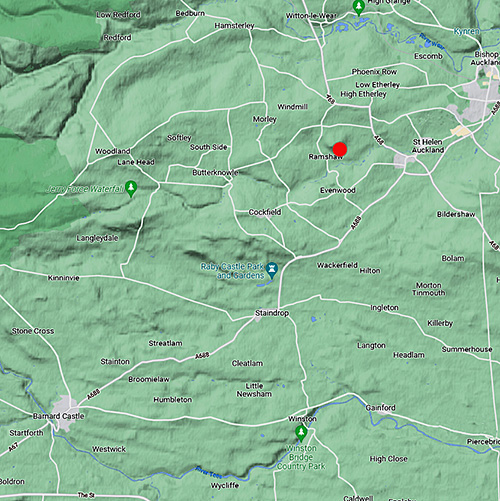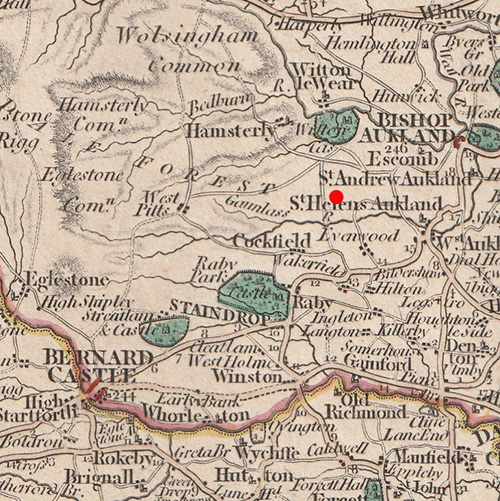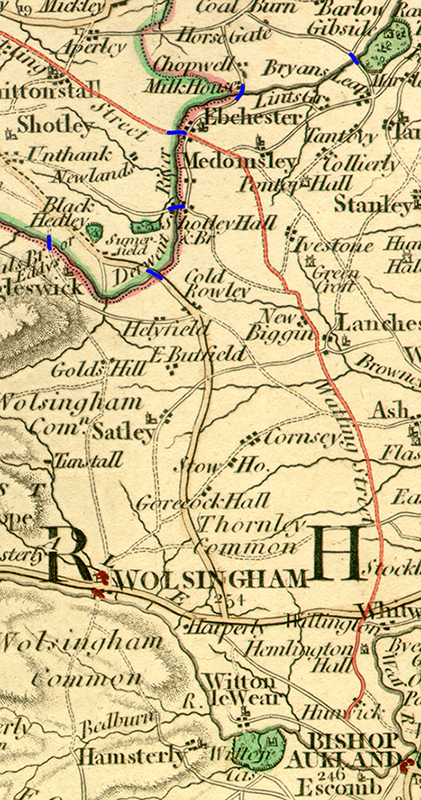|
Fox's route to County Durham and Northumberland By this stage, Fox is sufficiently familiar with the Northern counties not to detail his route as precisely as in the earlier stages of the Journal. We last hear of him ‘at Thomas Bewley’s’ at Haltcliff Hall in Cumberland, near Caldbeck. He then sets off ‘into Bishopric’, County Durham, the fief of the Prince Bishop. If he went from that general direction, he probably made for Appleby (perhaps via Penrith), and thence to Brough and the start of the Roman road across Stainmore to Bowes. The beginning and the end are marked by castles, themselves built on the sites of Roman forts.  John Cary New Maps of England and Wales with part of Scotland (London: 1794) sheet 59, detail This was (and still is) the main route from Cumbria across the Pennines towards Durham, the A66. It can be a desolate road, and very quickly cut off in winter, both by snow and high winds. Eric Bloodaxe is said to have met his end there in 954, either in battle or by assassination. |
|||

|

|

|

|
Fox was making for the house of Justice Anthony Pearson at Ramshaw (see next link) near West Auckland, where he had ‘a very large meeting’. At Bowes, the road forks: the southern branch makes towards Catterick, and the northern, now the A67, towards the crossing of the Tees at Barnard Castle. From there, he would have taken what is now the A688, through Staindrop and past Raby Castle, turning off through Evenwood before Bishop Auckland.   Cary’s map is oriented differently from the Google Map, and seems slightly squashed from north to south. Fox does not seem to have gone to Durham itself and, oddly, in the Long Journal (and thus in the 1694 edition) he does not mention going to Newcastle, which in the Short Journal is presented as an act of bravado because there were ‘many professors who had reported that Quakers would fly like butterflies, they would not come to great towns’. Equally strangely, there is no mention of his visit to either Northumberland or Durham in First Publishers, though the Northumberland Friends point out that the early converts have all died, and they have to depend upon secondhand reports. They do remember a disruptive visit by Miles Halhead in 1653 to Newcastle and County Durham; he was imprisoned at Newcastle, ‘but ye Lord made him a Burdensome stone to them, insomuch as ye Mayr sent for ye Sheriff & desird him to Release him, which they did’.1 Durham Friends remembered, in July 1653, ‘a Meeting in ye house of Anthony Pearson, at Ramshaw, near Bishop-Auckland, in the County of Durham, where severall were present, & some who with gladness Jmbrac'd the testimony of Truth’, but the person they remember conducting it was James Naylor. However, Naylor had come from Yorkshire, and ‘came noe further into ye County at that Time’,2 so it sounds as if his and Fox’s expeditions were separate. It would have been possible from Auckland for Fox to strike off north-west towards Hexham, crossing the River Derwent (‘Darrenwater’) — the Northumberland/Durham border — probably by the bridge at Ebchester. This would have meant joining Dere Street, the old Roman Road from York to Scotland, slightly to the east of Ramshaw, possibly at Binchester, the Roman fort of Vinovia.   Robert Mordern ‘The Bishoprick of Durham ’ (1695) detail. John Cary New Maps of England and Wales (London: 1794) sheet 59, detail. Morden’s 1695 map marks this as a route (labelled ‘Roman way’). Carey’s much later map (1794) mislabels it ‘Watling Street’ (marked pale red); and shows at least six bridges (marked blue) crossing the Derwent along that stretch. Mordern’s 1695 ‘Northumberland’ map (below) shows bridges over the Derwent at Shotley Bridge (though not Ebbchester), and further east, possibly a ford, at ?Allensford.  Robert Mordern ‘Northumberland’ (1695) detail. 1. First Publishers of Truth page 202. They are echoing Halhead's own account in A BOOK Of some of the SUFFERINGS AND PASSAGES OF Myles Halhead OF MOƲNT-JOY in ƲNDERBARROW in the County of Westmorland (London: A. Sowle, 1690) pages 11-12. See online version at the University of Michigan's Early English Books Online. Halhead says that this was in August 1653. He does not mention anyone else as being involved. Return 2. First Publishers of Truth page 88. Return Close window to return to text | |||